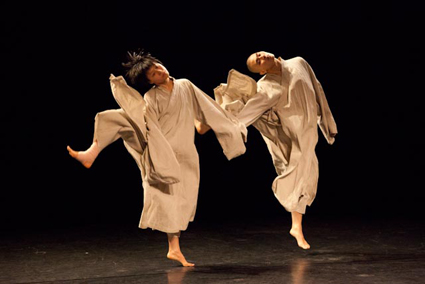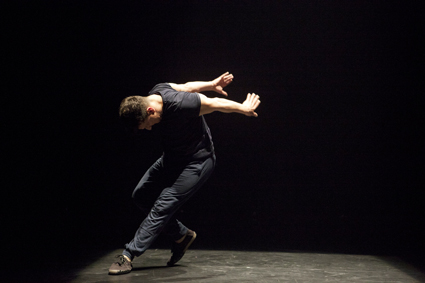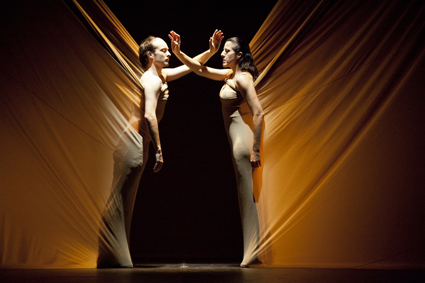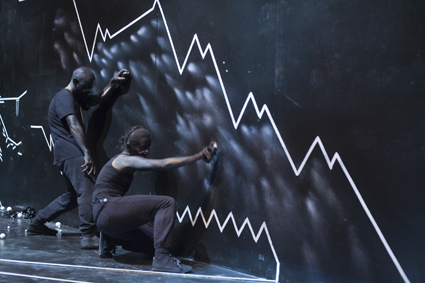not quite spring fever
keith gallasch, virginia baxter: spring dance

Tao Dance Theatre, Weight x3 / 2 Part 1
photo courtesy the company
Tao Dance Theatre, Weight x3 / 2 Part 1
SYDNEY SPRING, CURATED BY SYDNEY DANCE COMPANY ARTISTIC DIRECTOR RAFAEL BONACHELA, PROVED HUGELY POPULAR THIS YEAR, AND A FINANCIAL SUCCESS, ACCORDING TO PRESS RELEASES AND MEDIA REPORTS. WE THOUGHT THE PROGRAM DISTINCTLY PALLID COMPARED WITH THE BRIGHT OFFERINGS THAT GRACED WENDY MARTIN’S 2011 THEMATICALLY RICH PINA BAUSCH PROGRAM WITH DV8 PHYSICAL THEATRE (HELPMANN AWARD WINNER 2012 FOR BEST DANCE WORK, FOR CAN WE TALK ABOUT THIS?), LES BALLETS C DE LA B AND ISRAEL GALVÁN AMONG OTHERS, WHILE THIS YEAR’S AUSTRALIAN CONTENT, CLOUDS OVER BERLIN EXCEPTED, LOOKED DECIDELY GREY—UNDERDEVELOPED, NOT TO MENTION UNDER-RESOURCED.
The best work in the program from choreographer Tao Ye’s Tao Dance Theatre (China), was the first, Weight x3 / 2 Part 1, in which a male/female pair in loose clothing responded to Steve Reich’s Phase with elaborately timed and spatialised tandem walking, much of it hand in hand. The recurrent patterning, bodies relaxed but firmly erect, became more expansive and complex—heads flicked sharply to the side, legs momentarily raised and flexed at the knee, high kicks executed without interruption to flow, and a roll back onto the heel before stepping forward providing sudden propulsion. The subtle transformations in movement fitted beautifully with Reich’s phase shifts. When the dancers eventually ceased holding hands they still moved in parallel until they bumped into each other, a brief shock of a moment, a spell broken but then recast.
The second work, Weight x3 / 2, Part 2 , featured a female dancer as warrior twirling a long spear-like weapon, the speed increasing until she had conjured a bronze shield. However, a limited set of repeated movements and an unconvincing relationship with the music could not lift the work above tedium. The third piece, 2, focused on floor work with two dancers in grey costumes, mutually prostrate, not in sync but exercising similarly restless moves. They gradually assume postures of repose, heads resting on hands, elbows to the floor. Eventually they temporarily overcome gravity, walking and rocking in squat positions, executing shoulder stands and rolls, before returning to inertia—just when we hoped they would break free. The dancers were doubtless skilful but Tao Ye’s choreography was short on inventiveness.
iou projects: six solos and a bbq

Anton, IOU
photo Jess Bialek
Anton, IOU
The presentation of a selection of short solo works by Sydney dance artists looked admirable on paper, but in reality it hardly suggested a serious vote of confidence in the local dance scene. Poor production values were barely compensated for by an overtaxed if inventive lighting designer (Benjamin Cistern) working with smoke effects. The works themselves were sometimes short to the point of miniature and several were quite underdeveloped. IOU felt like a workshop showing if, fortunately, not without rewards.
Anton’s semi-improvised Supermodern 2.1 is danced antically in a constrictive pool of light, his limbs moving so fast he appears to have been strobed, fingers fluttering about his ears, body spinning, gesturing right and left as if attempting to broaden his boundaries. It’s enigmatic, distinctive and hypnotic, and apparently semi-improvised from an aspect of his recent work at Parramatta Riverside, Supermodern Dance of Distraction, a show that might have benefited both Anton and the Spring Dance audience had it transferred to the Opera House. In Awaken Absence, For Josh, Craig Bary danced on/with/to a chair, initially sitting on it in a variety of ways and then moving away, responding to the chair at a distance, and then returning. While his dancerly movements were fluently expressive, little was built out of the conceit of the engagement.
Martin del Amo performed two pieces, the first, 2 Sides 2 IT, Part 1 (Disorientation), an opaque if deliciously paced and articulated passage from his feature length work It’s a Jungle Out There. In Part 2 (What good is it sitting alone in your room?), Del Amo’s trademark ambulatory movement is replaced by a series of poses that evoke the choreography of Bob Fosse but without the steps from which they would usually resolve—it’s funny, quite sexy, eliciting amused recognition from the audience. This work at least seemed self-contained and complete.
After opening with a sustained, mood-calming headstand, Narelle Benjamin, in Nobody, went on to perform (to recorded sitar music) with a ritual sword, evoking that curious merging of warrior and philosopher embodied in many martial arts. The dancer’s relationship with the sword—extended, dipped, drawn close to the throat—suggests an aspiration towards oneness with one’s weapon. It’s a delicate, entrancing work which will benefit from clearer elaboration.
Kristina Chan’s enigmatic Lost & Found commences with her body vibrating, lowering herself to the floor, onto her belly, legs and arms lifting as if wavering in an unnatural pose. Her persona appears uncertain of her movement, of gravity, of her body—she pulls her singlet away from her and peers down at her breasts and then at her fingers and feet, and at us, before commencing a wider range of movements that, arms out, head down, suggest a truly lost soul. The work seemed considerably less coherent than the many works by others which Chan has so brilliantly danced.
The crowd-pleasing finale to IOU came from Timothy Ohl in Jack, drolly parodying TV talent quests. He’s Jack in a show called Master of None, adept at everything from ukelele to tap, Devo-ish robotics, hip hop and show-bizzy ballet in which he tragically contracts a prize-losing cramp. It’s an engaging, skilfully performed light entertainment, but no more than that, in which parody succeeds because it’s performed with skill and commitment.
maria pagés & sidi larbi cherkaoui, dunas

Sidi Larbi Cherkaoui, Maria Pages, DUNAS
photo Jess Bialek
Sidi Larbi Cherkaoui, Maria Pages, DUNAS
Dunas begins with two bodies shrouded in sand coloured gauze, straining towards one another. The separation proved to be a recurrent motif (though unintentional we suspect) in a work ostensibly about connection.
Last year’s Spring Dance gave us Israel Galván, a virtuosic exponent of Flamenco who showed us just what baring the elements of a traditional form can reveal. Dunas with Maria Pagés and Sidi Larbi Cherkaoui offered no such revelations. With two musical ensembles (piano and violin, guitar and percussion) largely hidden in the dark on either side of the stage a vital physical relationship between the music and the dance so crucial to Flamenco was erased though, thankfully, nothing could dampen the powerful voices of Ana Ramon and El Aribi Serghini that floated on the air.
Pagés is an impressive dancer with a strong, sinuous body but a superfluity of shared free-form movement between virtuosic Flamenco displays (including a spirited castanet solo) made her appear constrained by the format. Sidi Larbi Cherkaoui, whose collaborative work with Akram Khan (Zero Degrees, 2007) was so memorable and whose Sutras with Shaolin monks, featured at last year’s Spring Dance, is legendary, here seemed reduced to empty displays of ‘free-style’ movement with occasional Flamenco inflections (a protracted sequence of projected sand drawing gave some hint of his distraction). In this instance two dance forms met and had little to say.
contemporary women
Staged as sparely as IOU, Sydney Dance Company’s Contemporary Women program featured short works by Lisa Wilson (QLD), Larissa McGowan (SA), Emily Amisona (NSW) and Stephanie Lake (VIC).
Larissa McGowan impressed with Slack in Spring Dance 2009, a very distinctive, eerily surreal creation. In this much lighter work, Fanatic, a take on popular culture passions, she has her performers not simply mime the utterances of the humans and creatures in Alien and Alien vs Predator and those of their fans but brilliantly embody them, bigger than life, with immaculate precision. The outcome is very funny and quite spooky, if not particularly revealing. (See a review of McGowan’s Transducer.)
The strongest offering in the program was Stephanie Lake’s Dream Lucid with its opening image of a stamping, pulsating group of dancers. Gravity and attraction appear to be central to the work. A man lifts a visibly lightweight woman but the effort is almost beyond him. She appears to have magnetic control over him, drawing him offstage. Another pair demonstrates attraction with a dance of hands, his apparent dominance overcome when she traps him with scissoring arms. As the work moves towards a final merging of these beings, a vast field of static mimicking thunder, heavy rain and insects floods around them. Seven twitching automatons appear to hang off the back wall of the stage. Dream Lucid is bracingly mysterious, confidently constructed and forcefully danced.
We were uncertain about intent and choreographic execution in Lisa Wilson’s Desire and Emily Amison’s Yield, both built around two male-female couples. While some of the paired movements in Desire revealed an idiosyncratic choreographic sensibility the overall structure and meaning remained elusive. (See a review of Lisa Wilson’s Lake.) The quainter intimacies in Amison’s Yield proved just as puzzling, there was something afoot about relationships, deftly performed but less than tangible.
antony hamilton & melanie lane, clouds over berlin
Dancer-choreographer Melanie Lane’s Tilted Fawn, made with sound installation artist Chris Clark, achieves a nice balance between sound art and movement although it’s the sound that finally takes precedence, with the performer building a sonic world, literally, from ‘bricks’—small boxes containing speakers. On a shallow stage she shapes these into various configurations that evoke cities physically and aurally. Initially she simply turns each brick on, steps back and listens. The cumulative effect is at times orchestral. At other times the bricks are wielded like instruments from swung arms or stacked to created particular bodies of sound, cities of voices or the flow of static and mass media. Or the bricks become part of her, tucked beneath the chin, laid along an arm. Tilted Fawn is an intriguingly meditative performative installation, baffling some of Sydney Spring’s audiences, but opening them to the possible worlds that dance can build through cross-artform collaboration.

Antony Hamilton, Melanie Lane, Black Project 1
photo Ponch Hawkes
Antony Hamilton, Melanie Lane, Black Project 1
Antony Hamilton’s Black Project 1 is just as demanding in its own way, a substantial work warranting close attention and patience, its design and construction manifesting as a sizeable, emerging visual art work. At one end of a bleak wide wall are two slumped bodies (Hamilton and Lane) who come stutteringly to life, like cyborgs. Moving mechanically they evolve into something like high-end graffiti artists, very slowly transforming the space around them, ‘chalking’ it out in terms of their personal ground space and later on the wall in terms of their body proportions. They create a vast work with as much passion as their repressed bodies can express in this dystopia where soft clouds pass damply over them (video projection Olaf Meyer). But before their disappearance their art becomes magical, a two-dimensional world is transformed into a multi-layered one, meticulously un-peeled and crafted to reveal surprising depths and movement. This is a very strange world that Hamilton conjures, rooted in moody European comic book art, minimally hopeful in the manner of Beckett, and exquisitely realised.
Rafael Bonachela has two Spring Dance seasons ahead of him. Let’s encourage him to move beyond just showcasing local talent to giving a couple of choreographers the much-needed opportunity to present feature-length works in ideal conditions. As for the programming of international artists, let’s hope for a bolder selection.
Spring Dance 2012, curator Rafael Bonachela, Sydney Opera House, Aug 20-Sept 2
RealTime issue #111 Oct-Nov 2012 pg. 36






